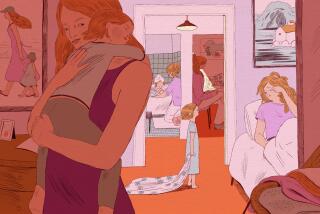When trash is one’s treasure
- Share via
Why keep things? They only take up space -- physical, mental, emotional. Einstein may have griped about what an empty desk might signify, but if he was around today, he wouldn’t even be able to get a job as an expert on a reality TV show with that attitude.
“Clutter is the symptom, but hoarding is the disease,” asserts David Tolin, the expert assigned to help Jill, a 60-year-old woman on the verge of eviction from her Milwaukee home on this week’s premiere episode of “Hoarders” (A&E;, 10 p.m. Monday). As collections go, Jill’s is among the more gruesome: she collects food, often letting it sit on the floor, or in her refrigerator, until it rots.
She’s one of two case studies on the premiere of this program, which retrofits the “Intervention” formula for a new disease: chronic accumulation. Like “Intervention,” “Hoarders” is stiflingly sober in tone, its cameras lingering on areas of brutal mess like crime scenes. But “Hoarders” isn’t passive: each subject is on the verge of crisis -- Jill is facing impending eviction; Jennifer and Ron, this episode’s other subjects, fear losing their children -- and is offered a life raft of two days’ help from professional organizers.
This help -- though, high-minded -- often feels futile. The show’s subjects are participating, if not against their will, then certainly against their instincts. Even as a worker in a filtered mask is attempting to dispose of a putrefied pumpkin, Jill is attempting to rescue seeds from it. Jennifer blithely tells Geralin, her assigned organizer, “The hallway is our laundry hamper, there’s always a carpet of laundry.”
As to why a pile of loose Cheerios is sitting on the floor, she notes with a laugh, “The dog doesn’t eat Cheerios.”
But while “Hoarders” is stern in its vision, it feels curiously hands-off in regards to root causes. Ron speaks repeatedly of his emotional attachment to “stuff,” but it’s never made clear why that might be the case. (“I feel like I may get sick,” he says to Geralin, as items are being removed from the house.) Jill explains that her food hoarding has to do with having previously been poor and unable to choose what she would eat, but beyond that, her need to keep products well past their expiration dates is never unraveled. David tries to use what appears to be dry wit -- “Are your perceptions of food completely accurate?” -- but barely scratches the surface of Jill’s compulsion.
Oddly, a more casual approach -- the armchair psychology of “Clean House” (Style Network, 10 p.m. Wed- nesdays) -- appears to be far more effective and appealing. “Clean House,” which has aired since 2003, is the grande dame of de-cluttering charity-television shows. In each episode, a family home is emptied of detritus, all of which is put out for a yard sale. The money raised at the sale is then put toward renovation and redecoration (though no family has ever received a subpar home for poor yard sale turnout).
In this show, families are eager participants -- they have called for the show’s help. And they take part in the yard sale, unburdening themselves in a secure, sometimes lucrative setting. Steering the ship is actress Niecy Nash (“Reno 911!”), who supervises the cleansing with arched eyebrow and drive-by therapy at the ready.
In one recent episode, two sisters moved into their recently deceased mother’s home. Darrell, husband to one, describes it as “a mortuary,” thanks to the sisters’ unwillingness to remove the mother’s furniture and possessions.
“This might sound mean,” he says, “but when my wife cries now, it really doesn’t bother me anymore.”
What “Clean House” uncovers is the emotional meaning behind objects, often at a micro level. And then it uses those disinterred feelings to foster a conversation about what’s led to the clutter, and the unhappiness, in the first place. Amid the show’s product placement and design tips, healing is a welcome side effect.
--
More to Read
The complete guide to home viewing
Get Screen Gab for everything about the TV shows and streaming movies everyone’s talking about.
You may occasionally receive promotional content from the Los Angeles Times.






